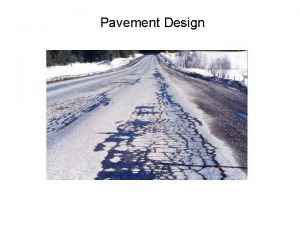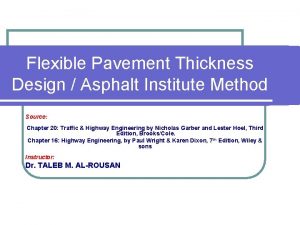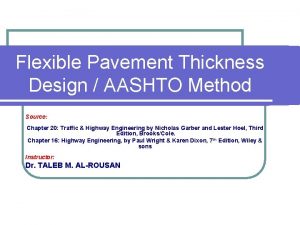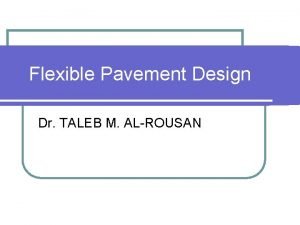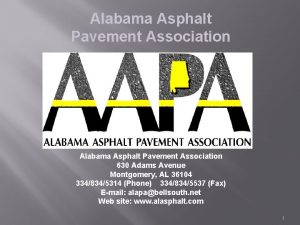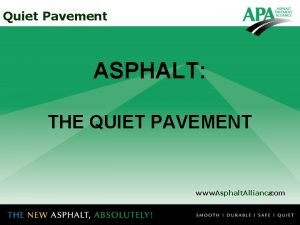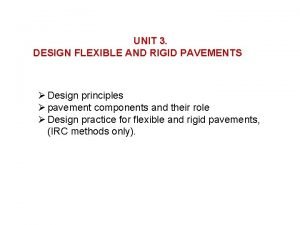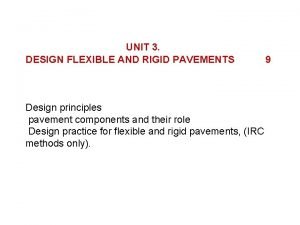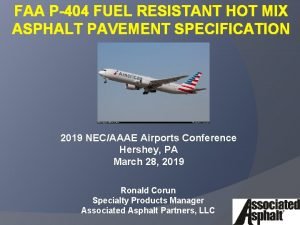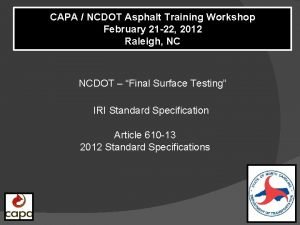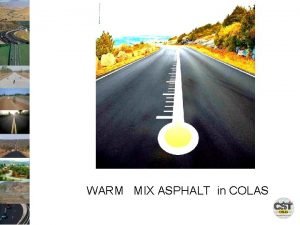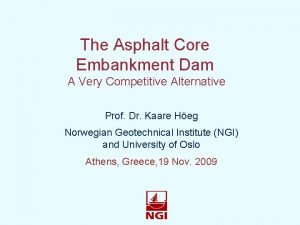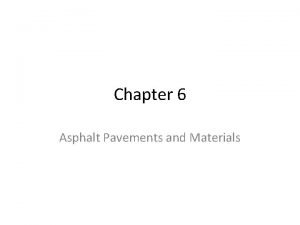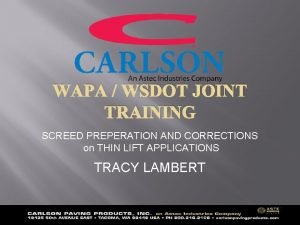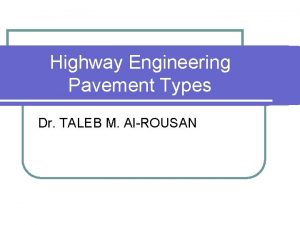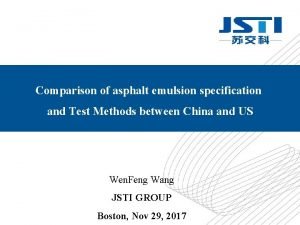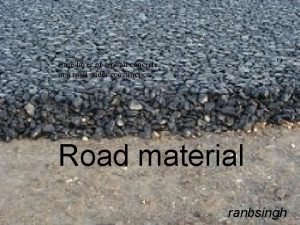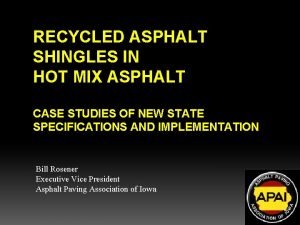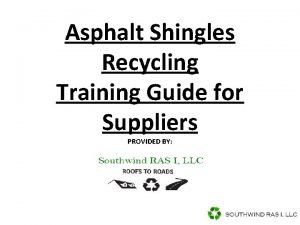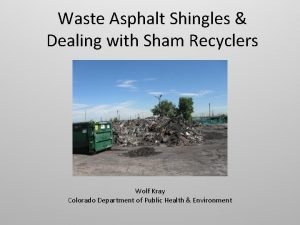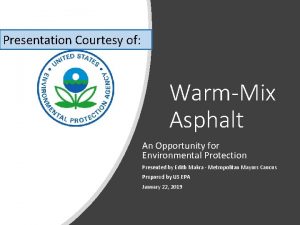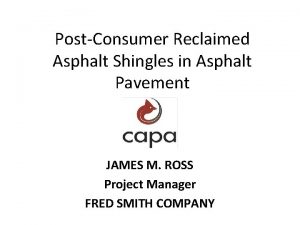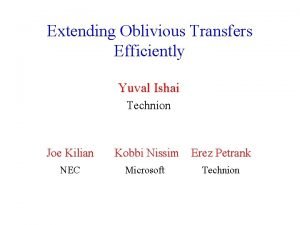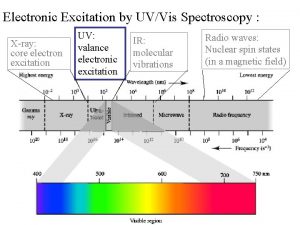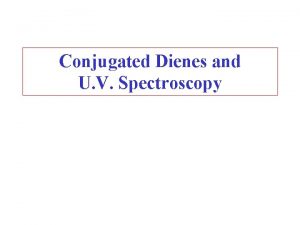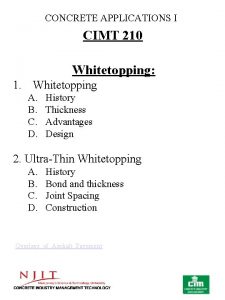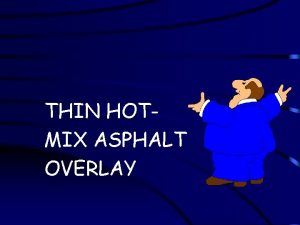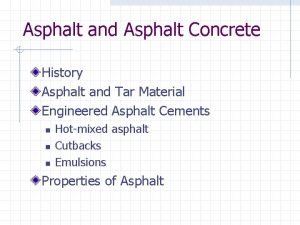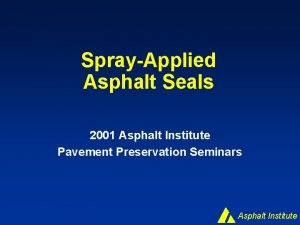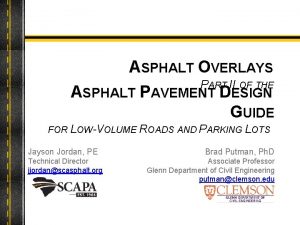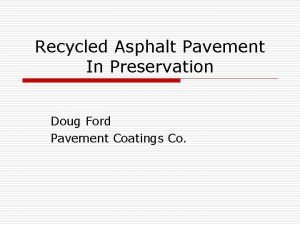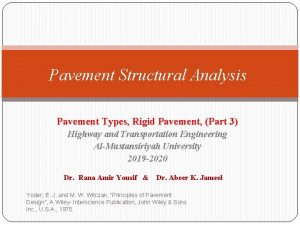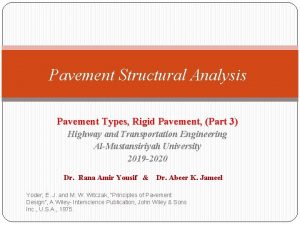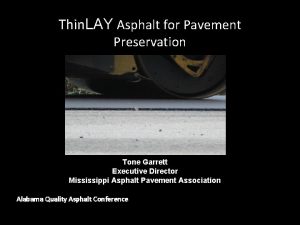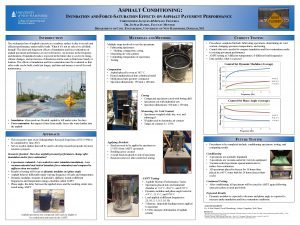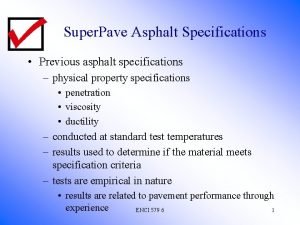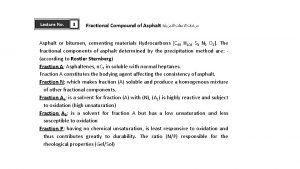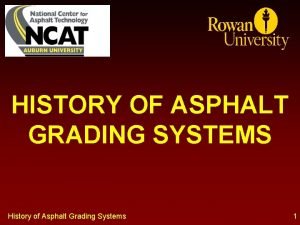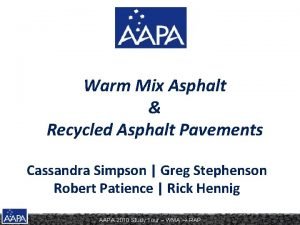Extending Asphalt Pavement Life Using Thin Whitetopping Mustaque




































- Slides: 36

Extending Asphalt Pavement Life Using Thin Whitetopping Mustaque Hossain, Ph. D. , P. E. Department of Civil Engineering Kansas State University

Disclaimer The contents of this report reflect the views of the authors, who are responsible for the facts and the accuracy of the information presented herein. This document is disseminated under the sponsorship of the Department of Transportation University Transportation Centers Program, in the interest of information exchange. The U. S. Government assumes no liability for the contents or use thereof.

Acknowledgements Sharmin Sultana University of Texas, Austin Slide design © 2009, Mid-America Transportation Center. All rights reserved.

Outline n n n Background Objective Modeling of Thin Whitetopping Pavement Results Conclusions Recommendations

Background n Whitetopping is the process of rehabilitating asphalt concrete (AC) pavements using a concrete overlay n There are three types of whitetopping: Ø Conventional: thickness > 8 in. Ø Thin: thickness = 4 -8 in. Ø Ultra-thin: thickness < 4 in.

Thin Whitetopping Pavement (US 287, Lamar, Colorado)

Thin Whitetopping Construction (I-70, Salina, Kansas)

Thin Whitetopping Pavement (I-70, Salina, Kansas)

Background n Whitetopping Interface Bonding Condition: Ø Ø Bonded Unbonded (After Rasmussen and Rozycki 2004)

Background n Cases where whitetopping is feasible: Ø Ø Ø Existing AC pavements highly deteriorated (rutted and cracked) Adequate vertical clearance No AC layer settlement issues

Background n Existing design procedures for whitetopping: Ø Ø Ø Ø AASHTO* Colorado* New Jersey PCA/ACPA Modified ACPA Illinois Texas* * Thin whitetopping only

Objectives n To assess the behavior of thin whitetopping (TWT) with respect to: n n n n Thin whitetopping thickness (5 in. , 6 in. , and 7. 5 in. ) Existing AC thickness (5 in. , 7 in. , and 9 in. ) Interface bonding conditions (Bonded and Unbonded) Existing AC modulus (250 ksi and 350 ksi) Shoulder (Unpaved or Paved) Temperature gradient To estimate the service life

Finite Element Modeling n n n Structure: Thin whitetopping (TWT) on existing AC pavement FE software: Solid. Works Pavement model: A three-layer pavement system: n n n TWT Existing HMA/AC layer Subgrade layer (After Mc. Ghee 1994)

Finite Element Modeling n Layer materials: Isotropic and linear elastic n Mesh: High quality n Symmetry: Both geometry and loading n Pavement segment : 3 -ft. wide & 30 -in. in depth n Joint spacing: 6 ft.

Finite Element Models With Tied and Paved Shoulder No Tied or Paved Shoulder

Model Loading • Loading: 20, 000 lbs on a single axle with dual tires (legal load in Kansas) • Loaded area: Rectangular, normal, uniform, and equal to the tire inflation pressure • Self weight: Considered for all layers

Model Loading F=10, 000 lbs No Paved Shoulder (After Dumitru 2006)

Analysis Results • The critical response, maximum transverse tensile stress, was found at the bottom of the thin whitetopping (TWT) layer • It varied from 75 psi for bonded 7. 5 -in. TWT to as much as 442 psi for unbonded 5 -in. TWT

Effect of Interface Condition

Effect of Interface Condition Unpaved Shoulder Paved Shoulder

Effect of TWT Thickness Bonded TWT with Paved Shoulder Unbonded TWT with No Shoulder

Effect of AC Thickness

Effect of Existing AC Modulus

Effect of Paved Shoulder

Effect of Temperature Gradient

Computation of Service Life • In PCA method, allowable load repetitions are calculated based on the stress ratio (= calculated tensile stress/modulus of rupture) • If the stress ratio is less than 0. 45, the pavement can take unlimited load repetitions

PCA model • For S. R. > 0. 55 • For 0. 45 ≤ S. R. ≤ 0. 55 • For SR < 0. 45 N=Unlimited S. R. = ration of flexural stress to modulus of rapture N = number of allowable load repetitions

Service Life (full bonding) (for various ADTT level)

Service Life (unbonded TWT & 5” AC)

Service Life (unbonded TWT & 7” AC)

Service Life (unbonded TWT and 9” AC)

Conclusions • Interface bonding is the most important factor that affects the longevity of thin whitetopping • Bonding has a more pronounced effect on transverse tensile stress for the unpaved shoulder condition that of the tied and paved shoulder condition • Thin whitetopping thickness has a more pronounced effect for the unbonded interface condition than the bonded condition

Conclusions (cont. ) • Tied, paved PCC shoulder decreases stresses in thin whitetopping • Tied, paved PCC shoulder is particularly useful for unbonded thin whitetopping with low truck traffic

Recommendations • Field experimentation to investigate actual behavior of thin whitetopping • The effect of environment, subgrade soil types, and different joint spacing can be investigated

Recommendations (cont. ) • Pavement response under moving loads would give a better approximation of the actual scenario • Partial bonding at the interface should be investigated as it is very difficult to achieve full bonding in the field

Thank You!
 Asphalt pavement design example
Asphalt pavement design example Cbr method of pavement design
Cbr method of pavement design Asphalt pavement thickness design
Asphalt pavement thickness design Aashto flexible pavement design
Aashto flexible pavement design Standard axle load for pavement design
Standard axle load for pavement design Alabama asphalt pavement association
Alabama asphalt pavement association Quiet pavement
Quiet pavement Flexible pavement
Flexible pavement Difference between rigid and flexible pavement
Difference between rigid and flexible pavement Flexible and rigid pavement
Flexible and rigid pavement P-401 faa
P-401 faa Asphalt rolling pattern
Asphalt rolling pattern Ncdot asphalt index
Ncdot asphalt index Warm mix asphalt
Warm mix asphalt Asphalt core dam
Asphalt core dam Asphalt
Asphalt Asphalt screed training
Asphalt screed training Contained rock asphalt mat
Contained rock asphalt mat What is this sing
What is this sing China cationic emulsified asphalt
China cationic emulsified asphalt Asphalt base layer
Asphalt base layer Rowe asphalt paving
Rowe asphalt paving S&b asphalt
S&b asphalt Determann asphalt
Determann asphalt Shingle recycling near me
Shingle recycling near me Recycled asphalt colorado springs
Recycled asphalt colorado springs Warmmix
Warmmix Fred smith asphalt plant
Fred smith asphalt plant X bar theory
X bar theory Emerging proficient extending
Emerging proficient extending Extending surface area and volume
Extending surface area and volume Extending oblivious transfers efficiently
Extending oblivious transfers efficiently Extending mendelian genetics
Extending mendelian genetics Spectrum xray
Spectrum xray Double bond extending conjugation
Double bond extending conjugation Karyotype
Karyotype Chapter 7 extending mendelian genetics
Chapter 7 extending mendelian genetics

